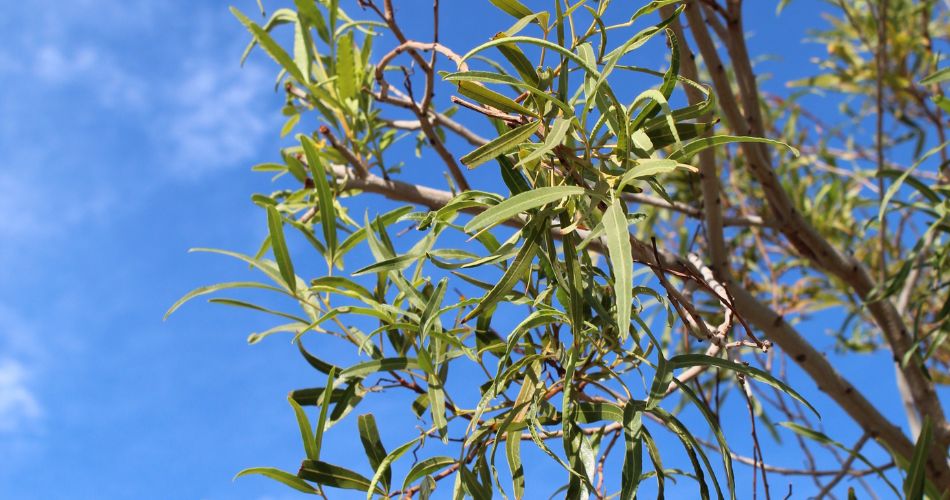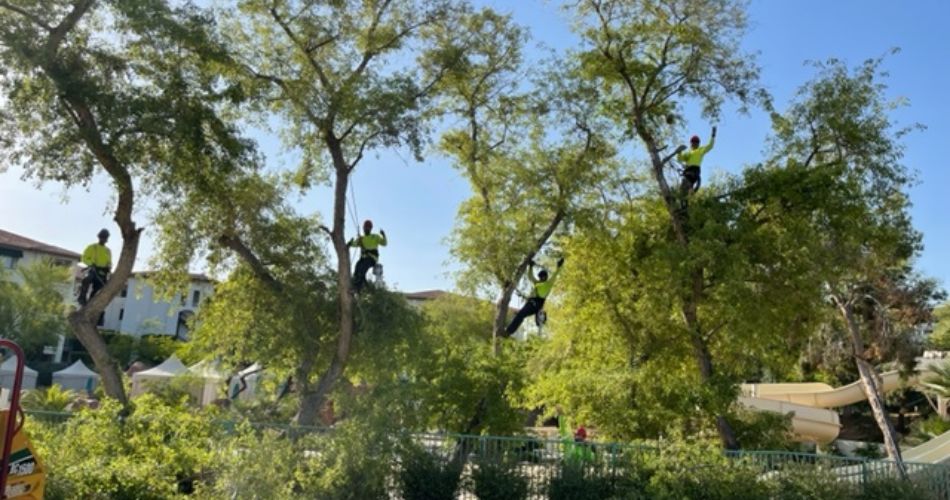
If you live in Anthem, there is a list of acceptable trees, plants, and shrubs that you can plant on your property, so chances are you don’t have any of the trees listed below.
For Phoenix-area residents in other municipalities, however, there’s a chance you may be considering planting (or may already have) one of the trees in this article.
There are some trees we recommend you do NOT plant on your Phoenix-area property, including trees that are invasive, don’t do well in our area, or are highly allergenic. Some of these trees have been banned already, but others have not.
>> Check this article for details about messy trees that drop a lot of tree litter.
Continue reading to learn the trees to avoid planting and why some trees just don’t work for your Phoenix yard.
Non-Native Trees
We recommend planting trees native to the Phoenix area whenever possible. Native trees know how to survive in our climate, are beneficial to the birds, bees, and other wildlife, and benefit our ecosystem.
Non-native trees, or trees that originated from other areas, often cause problems over time. Some are not well-adapted to our hot, dry climate and so don’t survive. Others come from similar areas but quickly reproduce and force out our native plants, becoming invasive and problematic.

Sitka Spruce (Picea sitchensis)
Native to Alaska and the California coast, Sitka spruce is an evergreen that thrives in areas where there is a lot of moisture. It also prefers soil that is rich and composed of a lot of organic material. Neither of those descriptions fits the Phoenix area, a desert with little year-round rainfall and very rocky soil.
Sitka spruces are the 3rd largest conifers in North America and can grow over 200 feet tall. It needs a lot of room to grow, and therefore and does not do well in the smaller lots that make up most Phoenix-area yards.
Most conifer trees, in fact, don’t grow well in the Phoenix area. If you want a conifer, consider the Arizona cypress or Aleppo pine, though both are still considered too large for residential yards.

Sissoo Tree (Dalbergia sissoo)
Also known as North Indian Rosewood or the shisham tree, the sissoo tree looks similar to an aspen tree. It was frequently planted as a shade tree – but has since been removed from some Phoenix-area neighborhoods, costing money for removal and replacement.
Native to India, Iran, and Nepal, the sissoo tree is found naturally along the banks of rivers and is adept at using its root system to find water. In fact, the roots can become over 40 feet long. The tree itself can grow to 60 feet tall and 25 feet wide. Its large size and invasive roots are the main reasons this tree seems to be removed so frequently – you need a large area at least 50 feet away from any structures or plumbing to prevent any issues.
As with other non-native trees, sissoo are trees that were brought in from other areas that at first seem to work well in our desert environment, but become problematic as they grow and adapt.

Queen Palm (Syagrus romanzoffiana)
Though most palms are not native to Arizona, they are still a familiar sight around the Phoenix area.
Even for palms that are not native, however, there are still distinctions – some are tropical palms, while others are desert palms. Queen palms are tropical palms, and therefore need a lot of water and benefit from high humidity. They struggle in our dry heat and when planted in our alkaline soil.
There are some workarounds, such as fertilizing with nitrogen, watering deeply (for several hours) every 7 to 10 days, and planting queen palms near swimming pools to take advantage of the added humidity, but often they are not worth the issues that they struggle with in our climate.
Invasive Trees to Avoid

Tree-of-Heaven (Ailanthus altissima)
You may have heard about this tree in the news lately, especially in relation to the east coast of the United States. That’s because this invasive tree, tree-of-heaven, is the main food source for spotted lanternflies, the pests that have rapidly spread after first being discovered in Pennsylvania in 2014.
Spotted lanternflies have negative effects on vines, hops, and a variety of trees, sucking out the sap and leaving behind sticky honeydew that attracts ants, bees, and wasps.
Tree-of-heaven, sometimes referred to as ailanthus, is considered invasive not just because of spotted lanternflies, however. This incredibly fast-growing tree is taking over areas that previously grew native plants and trees. It grows from seed or can resprout from roots, so it can grow back even if it is cut.
Tree-of-heaven stores water in its root system, making it very drought-tolerant, even here in the Phoenix area.
Not only does it spread quickly by seeds and roots, but it is known to produce a chemical called ailanthone that inhibits the growth of other plants, yet doesn’t impact the tree’s own seedlings.
The combination of being one the fastest-growing trees in North America, its ability to grow in most locations, its drought tolerance, its rapid reproduction from seeds and resprouting from roots, and its ability to restrict the growth of native plants makes the tree-of-heaven truly invasive. Hence, you should avoid planting this tree on your property.
If you have a tree-of-heaven on your property, we recommend that you have it removed as soon as possible.

African Sumac (Searsia lancea)
There are many native sumacs, most of which grow as shrubs with vibrant fall colors. However, African sumacs (as you can infer from their name) are not native to our area and were planted throughout Southern Arizona as street or neighborhood trees.
African sumacs have become invasive and noxious, are very messy trees (leaves and seeds fall from the tree year-round), and have allergenic properties. For instance, pruning the tree or getting too close can cause skin rashes, and burning the wood from an African sumac can cause respiratory problems.
Allergenic Trees
Even more allergenic than African sumac trees are olive and mulberry trees. These trees are already prohibited in many areas of Southern Arizona.

Olive (Olea Europaea)
Olive trees caused so many allergy and respiratory problems that they were banned from Phoenix and Tucson in the 1960s. Since 1986, a Phoenix city ordinance has prohibited the selling and planting of male olive trees (the ones that create a lot of pollen).
Some nurseries still sell “non-fruiting” olive trees advertised as non-allergenic, but even those have caused allergy problems.

Mulberry (Morus)
Similar to olive trees, mulberry trees are prohibited as noxious pollen producers in Phoenix. However, there are still many mulberry trees in the Phoenix area, which is one of the reasons why Phoenix-area dwellers suffer from allergies.
The Wrong Tree in the Wrong Place
Any tree is the wrong tree to plant if it is not suited for your yard. Before buying a new tree, research things such as:
- The mature size of a tree (how tall and wide it will grow)
- How much room the roots need (and if they are prone to ruin sidewalks or structures)
- Whether the tree produces a lot of “litter” like leaves, fruit, seeds, or nuts
- If there are thorns on the tree that passers-by may brush against
- Whether the tree is well-suited for our climate
- If your yard has enough room for the tree
- If any walls or structures will impact the tree as it grows
- How much sunlight or shade the tree needs
How to choose and plant the right tree for your Phoenix-area home >>

What Trees Can I Plant?
The Sonoran Desert has a plethora of native plants, trees, flowers, and grasses that work well in Phoenix-area yards. While many of our trees look different than those that naturally grow in other areas of the world, they are best adapted to life in the desert, and once established they are often able to live long, healthy lives on desert properties.
We encourage you to “plant native” whenever possible, as the trees are not only more likely to do well, but they benefit our native wildlife – including pollinators!
We have several articles on recommended trees to plant, including:
- Excellent Evergreen Trees
- 5 Best Spring-flowering trees
- Best Shade Trees
- Best Pal Verde Tree for Your Yard
- 5 Spring-Flowering Shrubs
- The Pros and Cons of Mesquite Trees
- About Desert Ironwood Trees
- About Arizona’s State Tree: Palo Verde
- Trees, Shrubs, and Flowers to Add Winter Interest
Titan Tree Care Can Help
If you have any of the problematic trees listed in this article, contact Titan Tree Care to schedule a tree removal.
We can also assist with tree and shrub planting, help you find the right trees for your specific needs, and give you information on trees to avoid planting in your yard.
Whatever your tree care needs - from planting and preventing pest or disease issues to removal - Titan Tree Care can help.
See Our Latest Articles
More Articles Like This

Titan Tree Care is a full-service tree care company located in Anthem, AZ and serving all of North Phoenix. We offer a wide range of services to meet your tree care needs, including tree and palm trimming, tree pruning, tree removal, stump grinding, and more. We also offer insect or disease treatments and fertilization services. We are dedicated to providing high-quality, safe, and effective tree care services to our customers and work hard to ensure that your trees are healthy and look their best.









